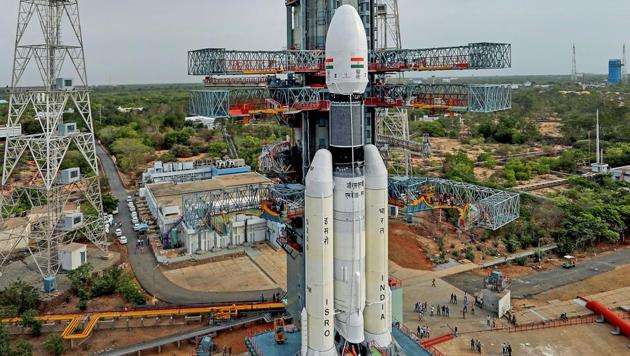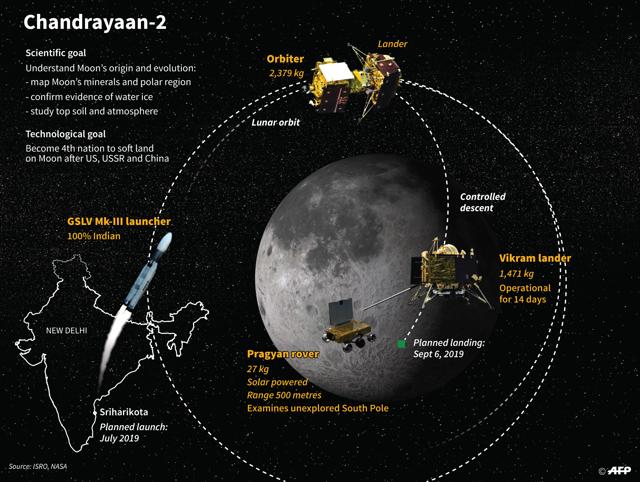Chandrayaan 2 launch 2019: India’s first lunar landing mission set for blast off
Chandrayaan 2 Launch Mission: Days before the 50th anniversary of Neil Armstrong’s first steps on Moon on July 20, 1969, India will launch Chandrayaan-2, the nation’s first lunar landing mission.
India will launch Chandrayaan-2, the nation’s first lunar landing mission, just days before the 50th anniversary of Neil Armstrong’s first steps on Moon on July 20, 1969.

“The payloads aboard Chandrayaan-2 will help in understanding the origin of moon and how it is related to the earth; it is like doing a DNA analysis. Expanding on the findings of Chandrayaan 1, the mission will also aim to observe water ice on the surface of the moon,” said DR Mylswamy Annadurai, the former director of ISRO satellite centre in Bengaluru.
The Mission Anatomy
Chandrayaan-2 consists of an orbiter, a lander and a rover together referred to as “composite body”.
1. Chandrayaan-2 will be launched from Satish Dhawan Space Centre at Sriharikota on-board GSLV Mk-III on July 15, 2019.
2. Chandrayaan-2 will be injected into an Earth parking orbit. A series of manoeuvres will raise its orbit and put it on lunar transfer trajectory. On entering the Moon’s sphere of influence, thrusters will slow it down for lunar capture.
Watch | 2 days to Chandrayaan 2 launch: Watch ISRO explain most ambitious mission
3. The orbit of Chandrayaan-2 around the Moon will be circularised to 100km orbit through a series of complex orbital manoeuvres with the help of thrusters.
4. On the day of landing, the lander – Vikram – will separate from the orbiter and then perform a series of manoeuvres comprising of ‘rough’ and ‘fine’ braking.
5. Imaging of the landing site region prior to landing will be conducted to find hazard-free and safe landing zones.
6. Vikram will finally land near the Moon’s South Pole on September 6 or 7, 2019. Subsequently, the rover – Pragyan – will roll out and carry out experiments on lunar surface for one lunar day (or 14 Earth days).
7. Orbiter will continue its mission for the duration of one year.
Also read | Chandrayaan 2 Launch 2019: What makes India’s moon mission special

The challenges
Trajectory: Ensuring trajectory accuracy over 384,400km to Moon while navigating the non-uniform gravitation pull of the Earth, the Moon, and other astronomical bodies.
Deep space communications: Communication will be only through weak radio signals with heavy background noise due to the massive distance.
Trans-lunar injection: To get to the lunar orbit and then land on the Moon, Chandrayaan-2 has to perform a series of complex burns to change orbit.
Also read | Chandrayaan-2 launch by ISRO: A look at space agency’s major achievements
Lunar orbit: Lunar gravity is lumpy due to uneven mass, influencing Chandrayaan’s orbit.
Lunar dust: Firing engines close to lunar surface results flow of dust, which is negatively charged and sticks to most surfaces and can cause disruption in deployment solar panel, sensors etc.
Temperatures: A lunar day is equal to 14 Earth days, resulting in extreme variation in surface temperature, along with the vacuum makes the environment hostile for operations.
Objectives of Chandrayaan-2 project
1. Studying and mapping the lunar terrain
2. Mineralogical analysis of rocks and soil
3. Studying the lunar ionosphere
4. Measuring moon-quakes and studying the lunar crust and mantle
Also read | Chandrayaan 2 moon mission all set for launch: 5 things to know






